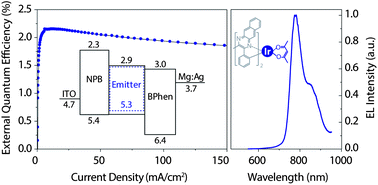For NIR-emitting organic light-emitting devices (OLEDs), platinum complexes have the record maximum external quantum efficiency (EQE), although such devices generally suffer from severe efficiency roll-off with increasing current densities. Here, we report on iridium complexes as a competent alternative for NIR dyes with high EQEs and negligible efficiency roll-off. A simple, charge-neutral iridium complex, iridium(III) bis(2-methyl-3-phenylbenzo[g]quinoxaline-N,C′) acetylacetonate (Ir(mpbqx-g)2acac, 1), has been synthesized and characterized by a strong NIR emission with λmax,peak at 777 nm and λmax,shoulder at 850 nm in CH2Cl2 solutions. The single-crystal and electronic structure as well as photophysical and electrochemical properties were systematically studied in comparison with its cationic counterpart [Ir(mpbqx-g)2(Bphen)]+PF6− (2, Bphen = 4,7-diphenyl-1,10-phenanthroline). Complex 1 has seven times the quantum efficiency of complex 2 because of its much stronger spin–orbit coupling. NIR-emitting OLEDs based on complex 1 have been fabricated with a bipolar gallium complex as the host. The devices achieved a maximum EQE of up to 2.2% (J = 13 mA cm−2) and a maximum radiant emittance (Rmax) of 1.8 mW cm−2. In particular, the EQEs remained around 2% over a wide range of current densities from 3 to 100 mA cm−2.

You have access to this article
 Please wait while we load your content...
Something went wrong. Try again?
Please wait while we load your content...
Something went wrong. Try again?


 Please wait while we load your content...
Please wait while we load your content...